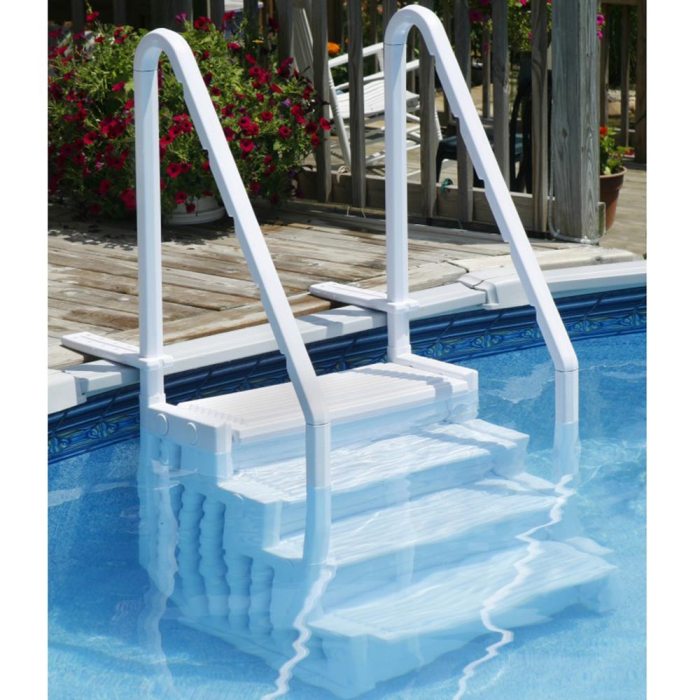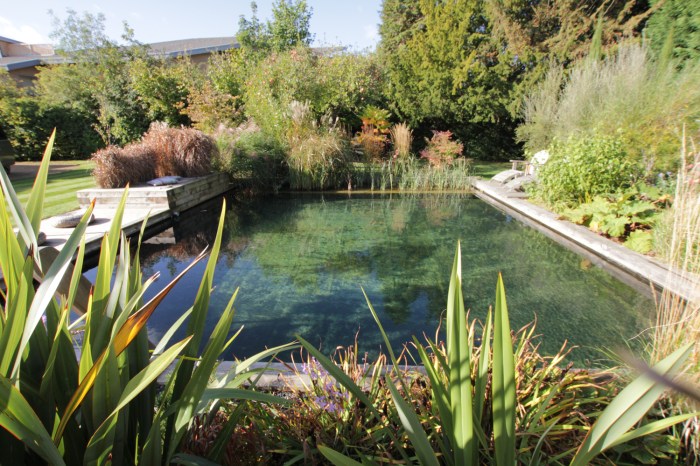DIY pool stairs can transform your backyard oasis, offering convenient and stylish access to your swimming pool. This comprehensive guide will walk you through every step of the process, from planning and design to installation and maintenance. Whether you’re a seasoned DIY enthusiast or a first-timer, we’ll provide you with the knowledge and resources you need to build a safe and functional pool stair system.
From selecting the right materials and tools to navigating building codes and regulations, we’ll cover all the essential aspects of creating DIY pool stairs. We’ll also offer practical tips, design ideas, and common mistakes to avoid, ensuring you achieve a successful and aesthetically pleasing outcome.
Planning and Design Considerations
Building pool stairs requires careful planning and design to ensure safety, functionality, and aesthetics. Understanding your pool’s unique characteristics is crucial for creating a comfortable and enjoyable swimming experience.
Pool Size, Shape, and Depth
The size, shape, and depth of your pool are primary factors influencing the design of your stairs. A large, deep pool might require a more elaborate stair system with multiple landings and handrails. Conversely, a smaller, shallower pool may only need a simple set of stairs. Consider the following:
- Pool Size: A larger pool will require more space for the stairs, potentially necessitating a longer, wider, or multi-level design.
- Pool Shape: The shape of your pool dictates the placement and configuration of the stairs. Rectangular pools offer straightforward placement options, while freeform or irregular shapes may require more creative solutions.
- Pool Depth: Deep pools will require more steps to reach the bottom, possibly including intermediate landings for safety and ease of access.
Determining the Optimal Number of Steps, Handrails, and Landing Areas
The number of steps, handrails, and landing areas should be carefully considered for safety and accessibility.
- Number of Steps: The optimal number of steps depends on the pool’s depth. The ideal step height is typically 6-8 inches, allowing for comfortable ascent and descent. Avoid excessively steep or shallow steps.
- Handrails: Handrails are essential for stability and support, particularly for older individuals or those with mobility limitations. Place handrails on both sides of the stairs, ensuring they are securely mounted and easily accessible.
- Landing Areas: Landing areas provide resting points for swimmers, particularly when ascending or descending long stairways. They also offer a platform for safety and convenience, allowing swimmers to pause and reorient themselves before continuing.
Building Codes and Regulations
Pool stair design must comply with local building codes and regulations to ensure safety and accessibility. These regulations typically cover aspects such as:
- Step Dimensions: Regulations often specify maximum step height and minimum tread depth.
- Handrail Requirements: Building codes typically dictate the height, spacing, and material of handrails.
- Landing Area Dimensions: Regulations may specify minimum landing area size and location.
- Materials: Building codes often specify acceptable materials for pool stairs and handrails.
- Accessibility: Regulations may require accessible features for individuals with disabilities, such as ramps or grab bars.
Safety and Maintenance: Diy Pool Stairs

Building DIY pool stairs requires a keen eye for safety and a commitment to proper maintenance. This section delves into crucial safety considerations during installation and provides valuable insights into maintaining your DIY pool stairs for longevity and safe enjoyment.
Safety During Installation
It’s essential to prioritize safety throughout the installation process. Proper handling of tools and materials is paramount to prevent accidents and injuries.
- Always wear appropriate safety gear, including safety glasses, gloves, and sturdy footwear.
- Use the right tools for the job and ensure they are in good working condition.
- Follow manufacturer instructions for all materials and tools.
- Take breaks when needed to avoid fatigue, which can lead to mistakes and accidents.
- Work with a partner or assistant whenever possible, especially for lifting heavy objects or operating power tools.
Ensuring Stability and Structural Integrity
The stability and structural integrity of your DIY pool stairs are crucial for safety. Here are key considerations:
- Use high-quality materials that are designed for outdoor use and can withstand exposure to water and weather conditions.
- Securely fasten all components, using appropriate fasteners and adhesives.
- Check for any signs of weakness or instability during the installation process.
- Consult with a structural engineer if you have any doubts about the design or construction of your stairs.
Maintenance Best Practices
Maintaining your DIY pool stairs involves regular cleaning, repairs, and inspections to ensure their longevity and safety.
- Clean the stairs regularly to remove debris and algae buildup.
- Inspect the stairs for any signs of damage, such as cracks, loose fasteners, or rust.
- Repair any damage promptly to prevent further deterioration.
- Consider applying a sealant to protect the stairs from water damage.
- Schedule regular inspections, at least once a year, to ensure the stairs are in good condition.
Common Mistakes to Avoid

Building DIY pool stairs can be a rewarding project, but it’s crucial to avoid common mistakes that can compromise safety, aesthetics, and longevity. Careful planning, precise execution, and attention to detail are essential for a successful outcome.
Incorrect Measurements
Inaccurate measurements can lead to misaligned steps, uneven surfaces, and structural instability. It’s crucial to measure twice and cut once, ensuring all measurements are accurate and consistent.
- Use a measuring tape to determine the exact dimensions of the pool deck, the desired height of the stairs, and the width of each step.
- Double-check all measurements, especially for angles and slopes, to ensure accuracy.
- Consider using a laser level to ensure horizontal and vertical alignment.
Improper Framing
The framing forms the backbone of your pool stairs, providing support and stability. Incorrect framing can result in weak structures, uneven steps, and potential safety hazards.
- Use pressure-treated lumber for framing, as it’s resistant to moisture and decay.
- Ensure the framing is adequately braced and secured to the pool deck and surrounding structure.
- Check for squareness and levelness throughout the framing process to ensure even steps.
Inadequate Finishing, Diy pool stairs
A well-finished surface is essential for both aesthetics and safety. Neglecting finishing details can lead to rough edges, uneven surfaces, and potential hazards.
- Apply a waterproof sealant to protect the wood from moisture and extend its lifespan.
- Use non-slip coatings on the steps to prevent slips and falls.
- Ensure all edges are smooth and free of sharp corners to avoid injuries.
Legal and Regulatory Considerations
Building a DIY pool staircase involves more than just construction. It’s crucial to understand the legal and regulatory requirements to ensure safety and compliance. Ignoring these aspects could lead to fines, legal issues, and even jeopardize the safety of your pool.
Permits and Approvals
Before you begin your project, it’s essential to obtain the necessary permits and approvals from your local authorities. These permits are designed to ensure that your pool staircase meets safety standards and complies with building codes.
- Pool Construction Permit: Most jurisdictions require a permit for any new pool construction or major modifications, including the addition of stairs. This permit typically involves an inspection to ensure that the pool and its components meet safety standards.
- Building Permit: Depending on your location and the scope of your project, you may need a separate building permit for the staircase construction. This permit will ensure that the staircase meets structural requirements and complies with building codes.
- Electrical Permit: If your staircase involves any electrical components, such as lighting or a handrail with built-in lighting, you’ll likely need an electrical permit. This ensures that the electrical work is performed safely and meets local electrical codes.
Pool Safety and Accessibility Requirements
Beyond construction permits, specific regulations govern pool safety and accessibility. These regulations are designed to prevent accidents and ensure that the pool is accessible to people with disabilities.
- Fencing and Gates: Most jurisdictions require a fence surrounding the pool area to prevent unauthorized access, particularly by children. The fence must be a specific height, with self-latching gates that open outward.
- Safety Features: Some jurisdictions may require specific safety features, such as pool alarms, safety covers, or life rings. These features are designed to alert homeowners to potential accidents and provide safety equipment in emergencies.
- Accessibility: The Americans with Disabilities Act (ADA) requires that pools and their associated facilities, including stairs, be accessible to people with disabilities. This may involve specific requirements for handrails, stair width, and the presence of a lift or ramp for wheelchair users.
Resources for Local Building Codes and Regulations
To ensure compliance, it’s crucial to consult your local building department or planning office. They can provide information on specific codes, regulations, and permit requirements for your area.
- Local Building Department: Contact your local building department directly. They are the primary source of information for building codes and permit requirements in your area.
- Planning Office: In some jurisdictions, the planning office handles zoning regulations, which may also impact pool construction.
- Online Resources: Several online resources provide access to building codes and regulations. These resources may include websites for your state, county, or city government.
Building DIY pool stairs is a rewarding project that can enhance your pool experience and add value to your property. By following the guidelines and advice Artikeld in this guide, you can confidently embark on this journey, creating a safe, stylish, and functional access point to your pool. Remember to prioritize safety, adhere to building codes, and enjoy the process of transforming your backyard into a haven of relaxation and enjoyment.
Building DIY pool stairs can be a rewarding project, adding both safety and style to your backyard oasis. While you’re focusing on the structural elements, consider incorporating a touch of whimsy with a playful accessory like a playboy bunny DIY costume for a pool party. Of course, the costume is purely for fun, but it’s a reminder that DIY projects can be a chance to express your personality and creativity, just like adding a unique design element to your pool stairs.

